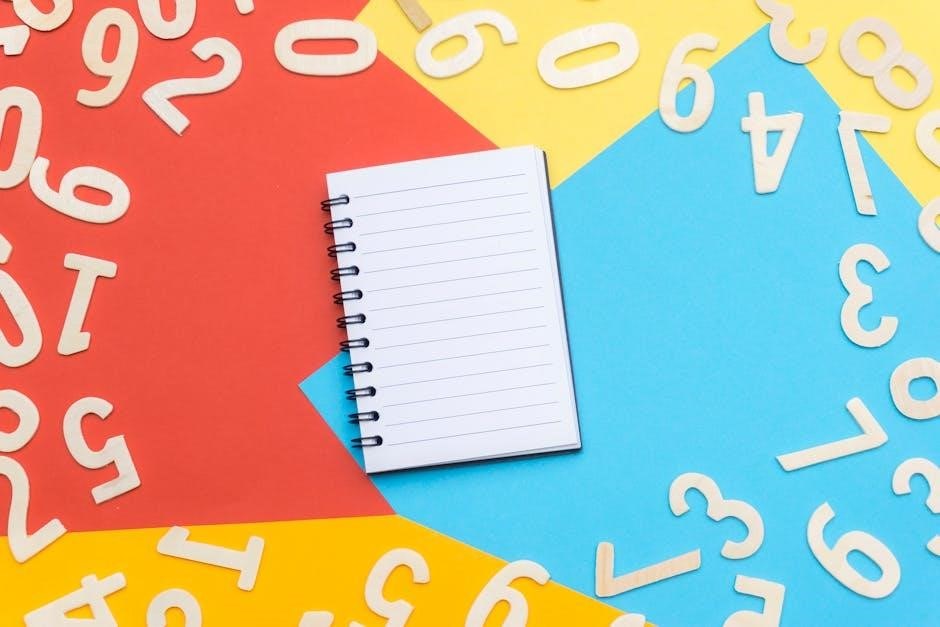and concise manner, making it easy for students to understand and apply geometric principles effectively always online;
Overview of Geometry Curriculum
The geometry curriculum for high school students typically includes a range of topics, such as points, lines, and angles, as well as more advanced concepts like theorems and proofs. A comprehensive curriculum will also cover different types of geometry, including plane and spherical geometry. Students will learn about the properties of various geometric shapes, including triangles, quadrilaterals, and polygons. The curriculum will also introduce students to the concept of coordinate geometry, which involves using coordinates to represent points and shapes on a plane. Additionally, students will learn about the importance of geometry in real-world applications, such as architecture, engineering, and design. By the end of the course, students will have a solid understanding of geometric principles and be able to apply them to solve problems and complete projects, making them more proficient in math and science subjects overall always.
Importance of Euclidean Geometry
Euclidean geometry plays a crucial role in the development of mathematical skills and problem-solving abilities in high school students. The study of Euclidean geometry helps students understand the concept of space and spatial relationships, which is essential in various fields like architecture, engineering, and design. A strong foundation in Euclidean geometry also enables students to develop critical thinking and analytical skills, as they learn to reason and prove geometric theorems. Furthermore, Euclidean geometry has numerous practical applications in real-world scenarios, such as calculating distances, areas, and volumes of various shapes and objects. By studying Euclidean geometry, students can gain a deeper understanding of the world around them and develop a strong foundation for further mathematical studies, making it an essential component of the high school geometry curriculum, with many online resources available for students to learn and practice.

Types of Geometry
Geometry includes plane and spherical types, with various subfields and applications, studied using different methods and approaches always online everyday.
Plane Euclidean Geometry
Plane Euclidean geometry is a fundamental concept in high school geometry, focusing on points, lines, and angles in a two-dimensional space. This branch of geometry is characterized by the Parallel Postulate, which states that through a point not on a given line, there is exactly one parallel line. The study of plane Euclidean geometry involves various theorems and properties, such as the properties of congruent and similar triangles, and the relationships between angles and sides of polygons. Students learn to apply these concepts to solve problems and prove theorems, developing their critical thinking and problem-solving skills. The use of coordinates and graphs is also introduced, allowing students to visualize and analyze geometric shapes and relationships. By mastering plane Euclidean geometry, students gain a solid foundation for further study in mathematics and develop essential skills in reasoning and problem-solving.
Spherical Geometry
Spherical geometry is a branch of geometry that deals with shapes and figures on the surface of a sphere. It is an important concept in high school geometry, as it helps students understand the properties and relationships of shapes in a curved space. In spherical geometry, there are no parallel lines, and the sum of the angles of a triangle is always greater than 180 degrees. Students learn to apply spherical geometry to real-world problems, such as navigation and astronomy. The study of spherical geometry also involves the use of specialized formulas and theorems, such as the law of cosines and the law of sines. By studying spherical geometry, students gain a deeper understanding of the relationships between shapes and spaces, and develop essential skills in critical thinking and problem-solving, which are valuable in a variety of mathematical and scientific contexts and applications.
Key Concepts in High School Geometry
Key concepts include points, lines, and angles, presented in a clear and concise manner, making it easy for students to understand geometric principles effectively always online every day.
Parallel Postulate
The Parallel Postulate is a fundamental concept in high school geometry, stating that through a point not on a given line, there is exactly one parallel line. This postulate is crucial in establishing the properties of parallel lines and angles. In the context of high school geometry, the Parallel Postulate is used to prove various theorems and corollaries, such as the corresponding angles theorem and the alternate interior angles theorem. The Parallel Postulate is also essential in understanding the concept of similar triangles and the properties of quadrilaterals. Furthermore, the Parallel Postulate has numerous applications in real-world problems, including architecture, engineering, and design. By understanding the Parallel Postulate, students can develop a deeper appreciation for the beauty and complexity of geometric concepts and their practical applications. The Parallel Postulate is a cornerstone of high school geometry, providing a foundation for further exploration and discovery.
Coordinate Geometry
Coordinate geometry is a branch of geometry that deals with the study of geometric shapes using coordinate systems. In high school geometry, students learn to graph points, lines, and curves on a coordinate plane, using equations and formulas to describe their properties. The concept of coordinate geometry is essential in understanding the relationships between geometric shapes and their equations. Students learn to use various techniques, such as plotting points, finding slopes, and determining equations of lines, to solve problems and model real-world situations. The use of coordinate geometry enables students to visualize and analyze geometric concepts in a more precise and efficient manner. By applying coordinate geometry, students can develop problem-solving skills and critical thinking, preparing them for advanced math courses and real-world applications. Coordinate geometry is a fundamental component of high school geometry, providing a powerful tool for solving geometric problems and modeling real-world phenomena.
Teaching Methods and Resources
Effective teaching methods and resources are essential for geometry education, including online materials and textbooks, to support student learning and understanding of geometric concepts always online effectively.
Discovery Approach to Geometry
The discovery approach to geometry is a teaching method that encourages students to learn geometric concepts through exploration and discovery, rather than simply being told the information. This approach is based on the idea that students will learn and retain more information if they are able to discover it for themselves. By using this approach, teachers can help students develop a deeper understanding of geometric concepts and principles. The discovery approach to geometry is often used in conjunction with other teaching methods, such as the use of technology and hands-on activities, to create a comprehensive and engaging learning experience for students. This approach is supported by various online resources and textbooks, which provide teachers with a range of tools and materials to support student learning and understanding of geometric concepts. Effective implementation of the discovery approach requires careful planning and execution by teachers.
Online Resources and Textbooks
There are numerous online resources and textbooks available to support the teaching and learning of high school geometry. Many websites offer interactive lessons, practice exercises, and quizzes to help students understand and apply geometric concepts. Some popular online resources include video tutorials, geometry software, and online textbooks that provide a comprehensive and engaging learning experience. Additionally, many publishers offer digital versions of their textbooks, which can be accessed online or downloaded to a tablet or computer. These digital textbooks often include interactive features, such as animations and simulations, to help students visualize and understand complex geometric concepts. Online resources and textbooks can be used to supplement traditional teaching methods, providing students with additional support and practice outside of the classroom. They can also be used to facilitate flipped classrooms and other innovative teaching approaches. Various online platforms are available to access these resources.
